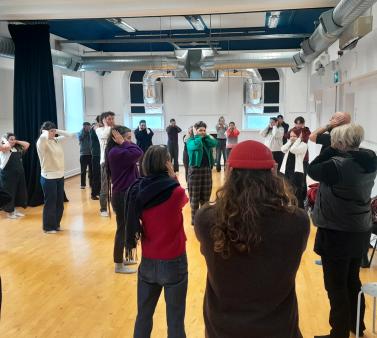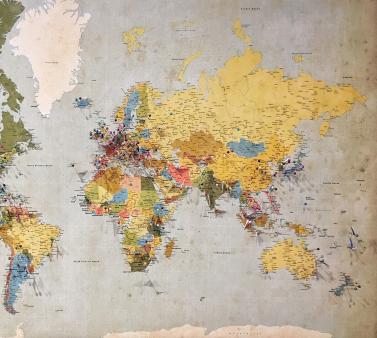
Vincent Dubreuil at the entrance of Hall B, on the Villejean campus, April 12, 2022.
You recently published an article in the magazine La Météorologie, entitled "Climate change in France illustrated by the Köppen classification". Can you explain this classification and the purpose of the article?
Köppen is a German author of the late 19th/early 20th century. He proposed a classification scheme of climates on a global scale, by matching the major vegetation limits to climatic thresholds of temperature and precipitation, averaged over periods of 30 years. This classification has been imposed worldwide thanks to its very simple combination of three letters - the first refers to the type of climate (hot, dry, temperate, etc.), the second to the distribution of precipitation in the year (summer or winter rainfall) and the third to the annual distribution of hot days. For example, the Breton climate is classified as Cfb - "C" for its temperate climate, "f" because it rains all year round, and "b" because the summer is not very hot - and all climates in the world are described like this.
In this article, we did two original things. First, we classified the climates of 40 cities in France in this way, comparing the current, past and future climate using climate projections. But everyone knows that some years are not like others in terms of climate; we remember a hot and dry summer like in 2003 for example. So in a second step, we studied the frequency of events, i.e. years that do not correspond to the average climate. In Brittany today, for example, the Breton climate prevails on average over a period of 30 years, but in this period, 1 year out of 12 or 13 is a Mediterranean year - Csa type: temperate climate, dry summer season, hot summer. What is interesting is that with this we introduce variability; the climate of a given region or city is characterized as a combination of possibilities.
What did you find out from the resulting maps?
One of the interests is that if we look at the climate over the last 60 years only through the 30-year averages, we might think that it has not changed much (+1° on average). If we look at each year, we can see a more subtle change. Climate change is not only a phenomenon that occurs smoothly and that we do not perceive, like the gradual increase in temperature. It is also the increase in the frequency of certain events. For example, in Brittany, we have gone from 40 to 60 days of heat per year, and the number of days of frost in the year has decreased - as a result, when they occur, it does more damage.
I will take the example of Rennes where we are. Thirty years ago, Mediterranean-type years were almost non-existent there. Today, they represent 7% of the observations, i.e. 1 year out of 12 or 13. In the future, in the middle of the 20th century, it will rise to 35% - 1 year out of 3 or 4 will be Mediterranean - and the average climate in Rennes will become "Charentais", i.e. temperate, with a dry and cool summer. If we project ourselves at the end of the century in a pessimistic trajectory, i.e. without action to reduce greenhouse gas emissions, Rennes would switch to an average Mediterranean climate, like ¾ of France. The Breton climate would disappear, and the Charentais climate would remain in Finistère and Cotentin. This is a problematic scenario from the point of view of water resources, and we must hope that it will not come to that.
What do you do as a scientist to fight against climate change?
My role is to communicate and disseminate information to as many people as possible, both through scientific articles that can be included in the IPCC (Intergovernmental Panel on Climate Change) summaries, and through more general articles such as this one or conferences for the public. I also participate in the Breton High Council for Climate, set up this year by the Region, which brings together 20 scientists to work on this issue at the scale of Brittany. And then we train our geography students at Rennes 2 in the mechanisms, issues and possible actions. For example, we study the natural and anthropogenic factors of change, and the levers we have in our hands to influence these trajectories. They are made aware of this and many of them do internships with local administrative bodies, particularly in the context of climate plans.
What measures do you think can be taken?
There are two levers for action against climate change. The first is mitigation, the implementation of policies to reduce greenhouse gas emissions, at the European, national and local levels through local authorities - the development of renewable energies or the implementation of public transport for example. The second lever consists of an adaptation policy. Based on the principle that the current climate will continue to change no matter what we do, by inertia, the idea is to implement actions that are compatible with the current and future climate. For example, the National Forestry Office (ONF) in Brittany has adapted its reforestation policy by replacing beech trees, which need coolness and humidity, with species adapted to a warmer and drier climate. In the region, we can already think about improving the management of water resources.
As the IPCC repeats, we all have the means to act. On an individual level and in our daily lives, we also have the means to take action: the way we consume and travel have an impact on whether or not climate change will accelerate. Recommendations are given in the latest IPCC report. But daily life will not be enough, we need global policies, starting with the respect of the Paris agreements.



